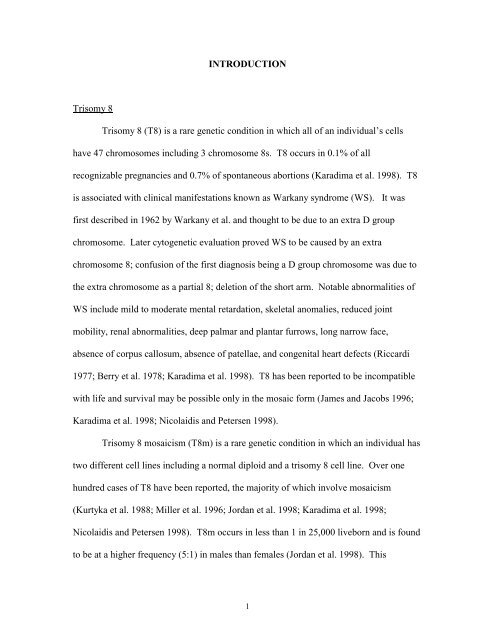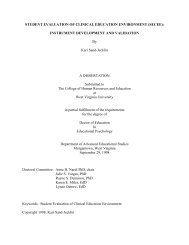TRISOMY 8 MOSAICISM: CELL CYCLE KINETICS AND ...
TRISOMY 8 MOSAICISM: CELL CYCLE KINETICS AND ...
TRISOMY 8 MOSAICISM: CELL CYCLE KINETICS AND ...
You also want an ePaper? Increase the reach of your titles
YUMPU automatically turns print PDFs into web optimized ePapers that Google loves.
Trisomy 8<br />
INTRODUCTION<br />
Trisomy 8 (T8) is a rare genetic condition in which all of an individual’s cells<br />
have 47 chromosomes including 3 chromosome 8s. T8 occurs in 0.1% of all<br />
recognizable pregnancies and 0.7% of spontaneous abortions (Karadima et al. 1998). T8<br />
is associated with clinical manifestations known as Warkany syndrome (WS). It was<br />
first described in 1962 by Warkany et al. and thought to be due to an extra D group<br />
chromosome. Later cytogenetic evaluation proved WS to be caused by an extra<br />
chromosome 8; confusion of the first diagnosis being a D group chromosome was due to<br />
the extra chromosome as a partial 8; deletion of the short arm. Notable abnormalities of<br />
WS include mild to moderate mental retardation, skeletal anomalies, reduced joint<br />
mobility, renal abnormalities, deep palmar and plantar furrows, long narrow face,<br />
absence of corpus callosum, absence of patellae, and congenital heart defects (Riccardi<br />
1977; Berry et al. 1978; Karadima et al. 1998). T8 has been reported to be incompatible<br />
with life and survival may be possible only in the mosaic form (James and Jacobs 1996;<br />
Karadima et al. 1998; Nicolaidis and Petersen 1998).<br />
Trisomy 8 mosaicism (T8m) is a rare genetic condition in which an individual has<br />
two different cell lines including a normal diploid and a trisomy 8 cell line. Over one<br />
hundred cases of T8 have been reported, the majority of which involve mosaicism<br />
(Kurtyka et al. 1988; Miller et al. 1996; Jordan et al. 1998; Karadima et al. 1998;<br />
Nicolaidis and Petersen 1998). T8m occurs in less than 1 in 25,000 liveborn and is found<br />
to be at a higher frequency (5:1) in males than females (Jordan et al. 1998). This<br />
1












